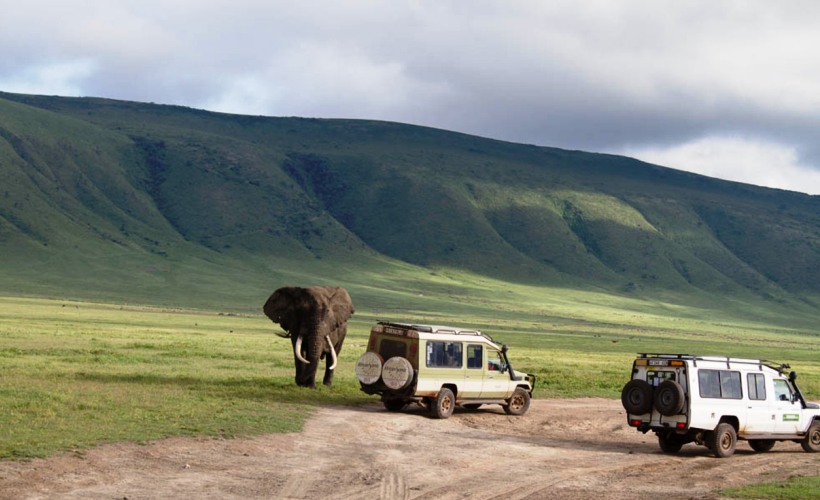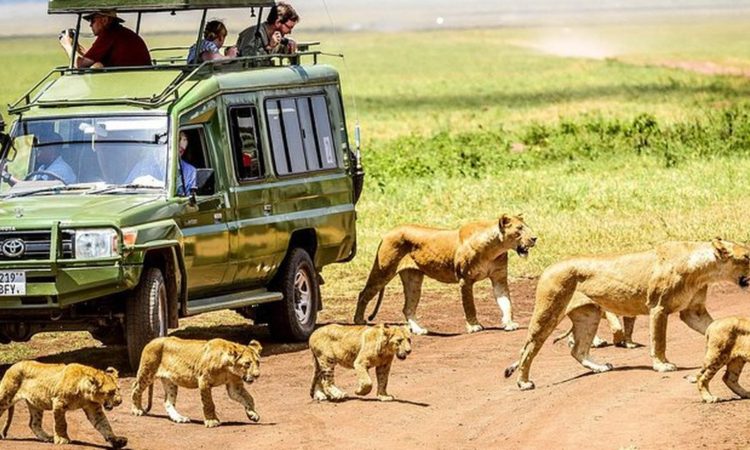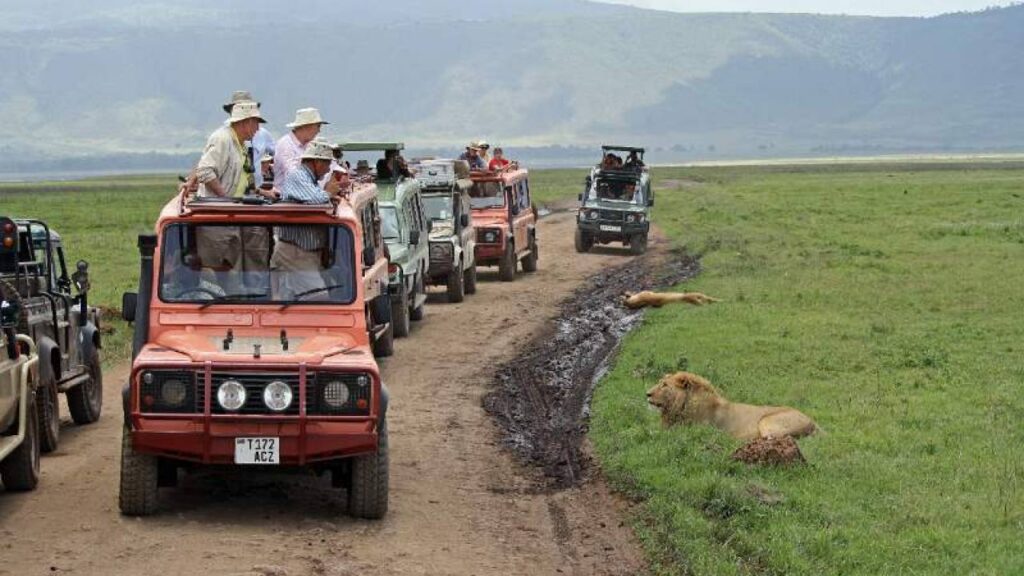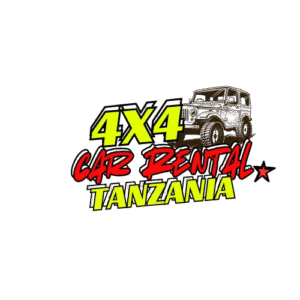Best Self Drive Guide to Ngorongoro Crater
The Ngorongoro Crater is situated in the northern circuit of Tanzania, serving as the primary hub for tourism inside the park. A solitary excursion to Ngorongoro crater immerses you in an authentic adventure narrative among the African environment. Ngorongoro is inhabited by formidable African felines, including lions, cheetahs, and leopards, as well as numerous impressive herbivores such as elephants, buffaloes, black rhinos, gazelles, zebras, and wildebeests. Additionally, exquisite species of birds congregate in the diverse ecosystems of the national parks, with flamingos adorning the shorelines of Lake Eyasi in vibrant pink hues.

Ngorongoro Crater
The Ngorongoro Crater in Tanzania is the largest caldera in Africa and is renowned as one of the most stunning natural wildlife attractions, not only in Tanzania but also in other regions of East Africa. Ngorongoro Crater National Park is designated as a World Heritage Site in Africa. It is posited that prior to the cataclysmic eruption that created the Ngorongoro caldera, there existed a volcanic mountain surpassing Kilimanjaro, the tallest peak in Africa. The volcanic debris surrounding Ngorongoro Crater is likely the cause of the lush vegetation in Ngorongoro Crater.
The allure of Ngorongoro Crater National Park is due to its picturesque rim, complemented by a series of rolling hills adorned with a lush carpet of vegetation. The rim of the Ngorongoro Crater rises approximately 400 to 610 meters above ground level. The crater conceals remarkable wildlife, including black-manned lions that traverse the grasslands, alongside various predators and herbivores that graze in the expansive savannah, acacia woodlands, and wetlands. The Ngorongoro Crater provides a stunning backdrop to some of Africa’s prominent and fertile grazing regions, including Tarangire National Park, Serengeti National Park, and Maasai Mara National Reserve, among others.
Attractions in Ngorongoro Conservation Area
Ngorongoro crater offers numerous marvels. The park features attractions both within the crater and throughout the entirety of Ngorongoro Conservation Area. The primary allure of Ngorongoro is its vast caldera, which is also part of the extensive Serengeti conservation area, renowned for the great migration of wildebeests and zebras, particularly the calving of wildebeests in the northern region of Ngorongoro Conservation Area

Wildlife
The fauna is distinguished among the many. Ngorongoro Crater offers accessible game drive safaris, delivering a gratifying experience in the African wilderness. Ngorongoro Crater conceals numerous large creatures, including Africa’s Big Five. The region adjacent to the crater’s rim is home to numerous black rhinos and large herds of elephants, including from 200 and 300 individuals. The savannah grasslands host numerous zebras, gazelles, cheetahs, foxes, and serval cats; leopards and other felines transform these grasslands into a hunting field for their prey, owing to the abundance of herbivores. You will also appreciate a variety of exquisite birds soaring in the sky of Ngorongoro, such as the flamingos near the soda lakes, among around 4,000 bird species.
Vegetation
The flora of Ngorongoro is an additional attraction throughout the region. The Ngorongoro Crater National Park features a diverse array of vegetation, encompassing lush forests alongside semi-arid savannah grasslands and woodlands. The savannah woodland comprises acacia trees, including the baobab and many candelabra tree species. The lowlands are characterized by marshes, while the highlands are adorned with unique tree species, such as zebrawood, near Lake Eyasi.
Birds
The Bird population in Ngorongoro Crater is exceptional and serves as a significant draw for people that flock to the region each year. Ngorongoro serves as a habitat for both resident and migratory birds that arrive from Europe and Asia around November. The migratory species, including European swallows, Caspian lapwings, European rollers, and Montagu’s harrier, are present in the national park during the wet season from May to April. Additional avian species in Ngorongoro Crater comprise ostriches, grey crowned cranes, kori bustards, and secretary birds, along with several other terrestrial birds. The aquatic avifauna of Ngorongoro Crater comprises waterfowl, waders, herons, and several flamingos in proximity to the soda lake within the park’s boundaries.
Ngorongoro Crater
The Ngorongoro Crater, from which the Ngorongoro Conservation Area derives its name, is a prominent attraction in the region. The Ngorongoro Crater is the largest caldera in Africa, measuring 264 square kilometers. Several meters from the primary entrance to Ngorongoro, one may observe an excellent vista of the caldera, together with various fauna in proximity to the crater and the flora interspersed with diverse savannah woodland tree types. The crater lakes, or soda lakes, within Ngorongoro Crater, host a diverse array of fauna and avifauna, with other notable characteristics of Ngorongoro Crater.

The Mountains of the Gods, popularly referred to as “Gol Mountain,” is another notable feature of Ngorongoro Crater National Park. The Gol Mountains, situated in the isolated northern region of Ngorongoro, are revered and feared by the Maasai people, the local residents. The Gol Mountains possess a profound cultural and traditional connection to the Maasai culture. The Gol Mountains region is the most culturally significant location in Tanzania.
Other attractions comprise the Olduvai Museum, situated on the edge of the famous Olduvai Gorge; it was uncovered by Dr. Leakey in 1959, following the discovery of the oldest remains of early humans. The other attraction in the region is Laetoli, located in the southern area near the Olupai Gorge, one of the most isolated locations; it is renowned for the various footprints attributed to Australopithecus afarensis.
How to get to Ngorongoro
By car, the Ngorongoro Crater is approximately 185 kilometers from Arusha via roadway. The journey may require two to four hours.
Flights – Daily flights operate from Arusha to Lake Manyara Airstrip. The journey to the Ngorongoro Crater takes approximately one and a half hours and is visually captivating. Arusha is accessible via two airports. Domestic Arusha Airport offers daily flights to several local destinations, whilst Kilimanjaro worldwide Airport provides daily flights from local, African, and worldwide carriers.
Accommodations in Ngorongoro Crater National Park
A diverse array of hotel options is available, depending on your trip budget. Ngorongoro is abundantly equipped with lodges, bandas, motels, and campsites that vary from luxurious to economical options. The lodging at Ngorongoro Crater National Park provides a distinctive safari experience in Tanzania, characterized by comfort, authenticity, and an ecological ambiance offered by the many hotels to visitors.
Ngorongoro Crater Lodge is a premier resort facility in Ngorongoro. The resort is situated adjacent to the Serengeti National Park entrance in northern Tanzania. The lodging has three camps: South Camp, North Camp, and Tree Camp, each differing in price. The accommodations at the Ngorongoro Crater Lodge offer a magnificent vista of the rolling hills and the crater’s rim, as well as abundant wildlife, including lions.
Ngorongoro Serena Safari Lodge is an accommodation facility located on the western rim of the Ngorongoro Crater, with excellent views of the caldera below. The Ngorongoro Serena Safari Lodge is a tranquil establishment providing lodging in cottages designed with traditional elements, with hand-painted artwork that reflects African culture. The lodge features a comfortable restaurant adjacent to the fireplace, providing a wide array of meal options and a tranquil atmosphere.
Ngorongoro Sapa Lodge is situated on the eastern flank of the Great Crater; it can be accessed within an hour and a half drive from Manyara Airstrip and is approximately three and a half hours from Arusha. Ngorongoro Sapa Lodge provides lodging in spacious rooms, approximately 92 in total, each including a glass balcony that affords unobstructed views of the park’s wildlife in the distant savannah. It features a contemporary lounge with a comfortable restaurant, en-suite bathtubs, and exceptionally big rooms to enhance your experience during your visit.
Additional lodging options in Ngorongoro Crater National Park comprise Ngorongoro Wildlife Lodge, Kirurumu, and Lemala Ngorongoro Camp, among others. The various lodging options in the Ngorongoro Conservation Area provide breathtaking vistas of the park and opportunities for relaxation, including hotels situated both within and beyond the Ngorongoro Crater National Park, extending to Karatu and Ndutu.
